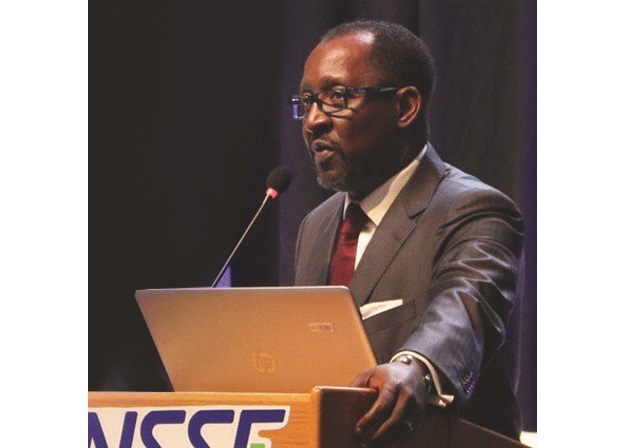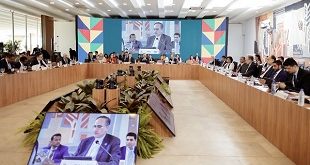
Savers suggests Fund’s flexibility to allow them access part the saving to meet their needs
Kampala, Uganda | JULIUS BUSINGE | The National Social Security Fund (NSSF) members are expected to earner higher returns on their savings for the 2017/18 financial year, according to its Managing Director, Richard Byarugaba.
Byarugaba told The Independent on the sidelines of the 2017 5th Annual General Meeting at the Kampala Serena Hotel on Sept. 28 that this new financial year looks better due to recovery of equity markets amidst declining interest rates.
“We believe that the gains that we will make on the equity market notwithstanding the geopolitical problems in Kenya should mean that we pay a descent return to our members in the next financial year,” he said.
Kenya plans to go to a repeat poll on Oct. 26 following nullification of President Uhuru Kenyatta’s win more than a month ago.
Byarugaba’s consolation message was in line with the bad news that had been delivered by the State Minister of Finance for Investment and Privatisation Evelyn Anite, who declared 11.23% as interest rate to be paid on members’ savings for the financial year 2016/2017, which is lower than the 12.3% paid out for FY2015/2016.
Byarugaba said the Fund’s gross return on investment reduced from 14% in FY2015/2016 to 13.5% in FY2016/2017 because asset base grew much faster than its return due to declining interest rates in reflection of the economy.
He revealed that the decline in interest paid out this year is attributed to lower earnings from the Fund’s fixed assets portfolio (government treasury bonds) that swallows 87% of its investment capital.
Since last year, the central bank has reduced the monetary policy rate – the central bank rate from 17% last year to 9.5% in October to stimulate economic activities, a move that reflected the decline in the Fund’s earnings from government securities.
Byarugaba said although the interest rates have gone down, the Fund has maintained an interest rate of more than 11% and above 8.68% average inflation for the last 10 years.
He said the Fund’s investment diversification strategy has boosted performance in that when interest rates are falling in the fixed income area; equities are always trying to perform better and so is real estate helping in protecting the Fund from bad inflation.
Fund’s size expands
Meanwhile, the Fund’s size grew by 20% from Shs 6.6 trillion in 2016 to Shs 7.9 trillion in 2017 with compliance levels growing to 80% from 78% in 2016 while contributions grew by 15% to Shs 917 billion from Shs785 billion in 2016, according to its financial report.
Byarugaba attributed this growth to its aggressive investment and marketing strategy as well as improved compliance levels from members. Compliance was 69% in 2011/2012.
Byarugaba said that with an income of Shs 912 billion on Shs7.924 trillion, the Fund’s return on assets (11.51%) is above the industry average of 8%, according to the industry regulator, the Uganda Retired Benefits Regulatory Authority report for 2016.
The number of days taken to process members payments has reduced from 36 days in 2012 to 10 days as at end of June 2017. Benefits paid out to members increased by 16% to Shs 278bn in 2017. In 2011/2012, it was Shs 101 billion. The Fund’s membership is recorded as 1.8 million as of June 2017.
Looking beyond current numbers, Byarugaba said that the fund is positioned to take advantage of the growth opportunities as the economy rebounds on the back of increased investment and productivity in key sectors of agriculture, tourism and minerals, oil and gas as well as the informal sector.
Meanwhile, the most outstanding issue that came up during the AGM had to do with how far the pension reforms have reached given that legislators were concentrating on political motions and bills at the expense of other bills like the Pension Sector Liberalisation Bill that has been in Parliament since 2011 .
However, Anite said the government is handling the reforms in close consultation with all stakeholders.
But some members were of the view that pension reforms concentrate on amending the NSSF Act to cater for what is being suggested as contents in the would be Pension Sector reforms rather than entrusting workers money with small players.
The NSSF Board Chairman, Patrick Byabakama Kaberenge said the Fund is equally waiting for new reforms to be empowered to judiciously know where to invest the contributions beyond current areas that are dedicated to them in the 1985 NSSF Act.
He said the Board supports the idea of having mid-term access of some percentage of contributions by a member like it is done in other countries.
“It is ridiculous for a saver to have two hundred million on his or her NSSF account but cannot pay three million shillings for his daughter or son at University,” Kaberenge said.
“We need to get that flexibility to allow savers to access their money for housing, health, education and other misfortunes that happen in life,” he added.
On the other hand, Byarugaba said once the new reforms are actualised, the key question will be looking at how much will be required for pension, mid-term access and the amount that will be required for other things like unemployment, benefits and more.
But he said for mid-term access to happen, it would require increasing on the current contribution given that the average amount that savers get out of NSSF after retirement is Shs 15 million which is little.
“We need to do more in terms of reforms, products and other systems to be able to benefit the members,” Byarugaba said. Currently, an employer pays 10% and the employee 5% to the NSSF as employee savings for retirement age.
****
 The Independent Uganda: You get the Truth we Pay the Price
The Independent Uganda: You get the Truth we Pay the Price



